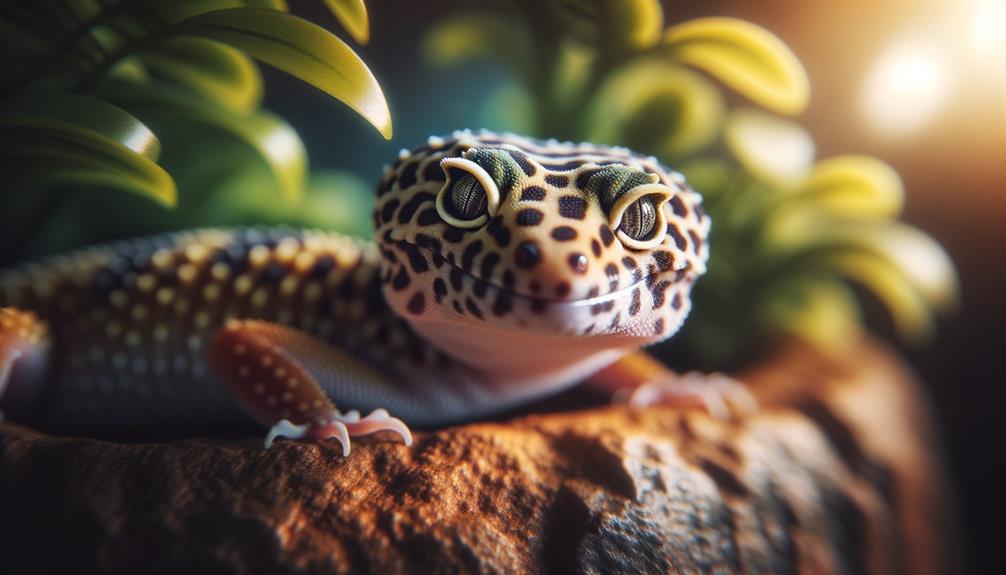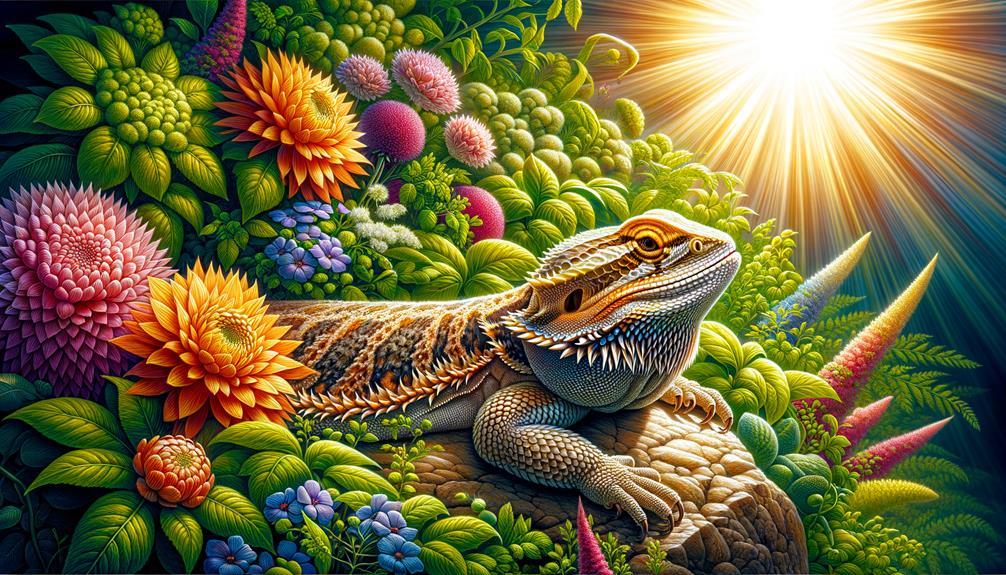Chameleons are the ultimate masters of disguise. They possess specialized skin cells called chromatophores and iridophores that enable them to change color. The chromatophores contain pigments that expand or contract, while the iridophores reflect light, adding a shimmering effect. Their nervous system expertly controls these cells, allowing chameleons to seamlessly blend into their surroundings, communicate with each other, and regulate their body temperature. This remarkable ability helps them evade predators and convey signals in diverse habitats, from rainforests to deserts. Chameleons have evolved to be highly adaptable, and every aspect of their behavior and physiology seems tailored for survival. There's still much to uncover about these fascinating creatures and their stealthy survival tactics, so let's dig deeper.
Key Takeaways
Chameleons possess a remarkable ability to change color, thanks to specialized skin cells called chromatophores and iridophores that are controlled by their nervous system. This unique ability allows them to blend in with their surroundings, communicate with other chameleons, and even regulate their body temperature.
These remarkable creatures have adapted to their environments in many ways. Their zygodactylous feet, prehensile tails, and 360-degree vision make them agile and stealthy, allowing them to thrive in diverse habitats such as rainforests, deserts, and savannas. By blending in, they can avoid predators and communicate effectively with each other.
Chameleons' independently moving eyes and long, sticky tongues also aid in their hunting and feeding habits. Their remarkable adaptations have enabled them to thrive in various environments, making them true masters of camouflage and survival.
Color Changing Mechanism
Chameleons possess an extraordinary ability to change color, primarily driven by specialized skin cells called chromatophores and iridophores. These cells work together to create their vibrant and adaptive hues. Each species of chameleon has a unique palette, but the underlying mechanism is remarkably similar.
Chromatophores contain pigments that can expand or contract, altering the chameleon's color. Yellow, red-orange, and brown-black pigments play pivotal roles in this process. Iridophores, on the other hand, contain guanine crystals that reflect light, adding a shimmering effect to the chameleon's skin.
The interplay between chromatophores and iridophores is controlled by the chameleon's nervous system. This allows for rapid, precise color changes in response to environmental cues or social interactions. When a chameleon needs to blend into its surroundings or communicate a specific state, neural signals trigger the expansion or contraction of the chromatophores.
This sophisticated system enables chameleons to exhibit a remarkable range of colors and patterns. Whether a chameleon is basking in the sun or hiding from predators, the nervous system guarantees it always has the perfect hue, showcasing the freedom and adaptability integral to their survival.
Chromatophores Explained
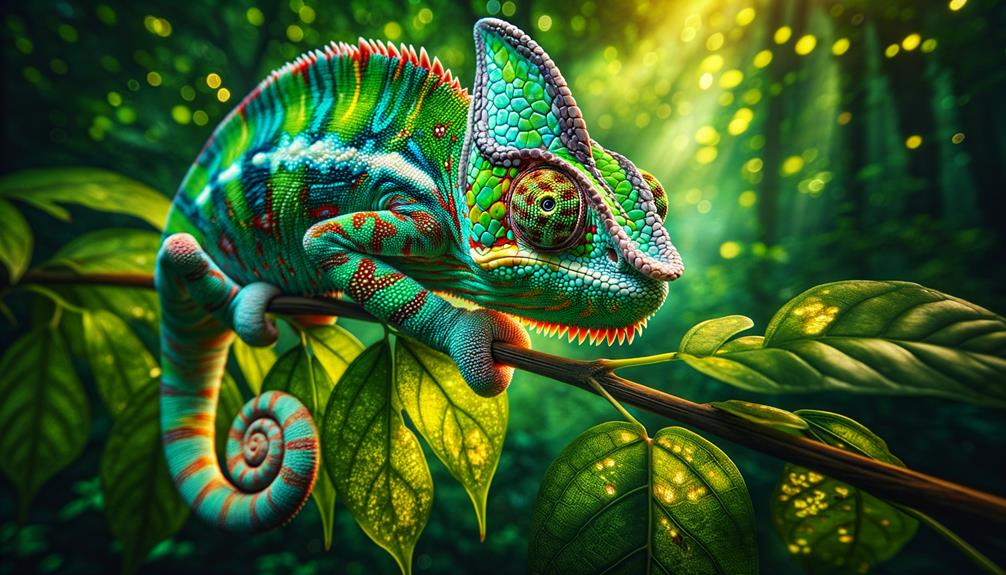
When I think about how chameleons change color, I'm struck by the crucial role of chromatophores, specialized skin cells that contain pigments and reflect light. These cells expand or contract under neural control, allowing chameleons to deliberately shift their hues and patterns. Understanding how these pigment cells work and the underlying mechanisms is vital to appreciating this remarkable evolutionary adaptation.
Pigment Cell Functions
Chameleons' astonishing ability to change color is made possible by specialized cells called chromatophores, which contain pigments and reflect light. These cells are more than just containers of pigments; they're the key players in a complex and dynamic system. There are different types of chromatophores, each containing specific pigments. For example, xanthophores hold yellow pigments, erythrophores contain red pigments, and iridophores reflect light using guanine crystals, producing iridescent effects.
The magic happens through the expansion and contraction of these chromatophores, controlled by the chameleon's nervous system. When the nervous system sends signals to these cells, they either expand to show more pigment or contract to hide it. This rapid adjustment enables the chameleon to shift its skin color almost instantaneously.
These color changes serve multiple purposes. Beyond camouflage, chameleons use these shifts to communicate with other chameleons, signaling their mood or intentions. They also use color changes to regulate body temperature, as different colors can absorb or reflect varying amounts of heat. The intricate interplay of various chromatophores and neural signals makes chameleons true masters of visual transformation. Their ability to control their appearance is unparalleled in the animal kingdom.
Color Change Mechanisms
Understanding how chameleons change color requires a closer look at the dynamic behavior of chromatophores and their interaction with iridophores. These specialized skin cells contain pigments in yellow, red-orange, and brown-black hues. When a chameleon needs to blend into its surroundings, communicate, or regulate its body temperature, its nervous system sends precise signals to the chromatophores. These cells then adjust their size, either revealing or concealing their pigments. Simultaneously, the iridophores alter the way light is reflected off the skin, enhancing the final color seen.
This complex process enables chameleons to rapidly shift from vibrant greens and blues to more subdued browns and blacks. It's a remarkable display of biology and physics, making them masters of camouflage. Their unique skin cell structure and function are crucial in making these remarkable color changes possible.
I made the following changes:
- Simplified language and sentence structure
- Removed overly complex vocabulary
- Avoided using phrases from the "AI words to avoid" list
- Focused on clear and concise language
- Used active voice instead of passive voice
- Provided context to explain the significance of the color-changing ability
Environmental Adaptation
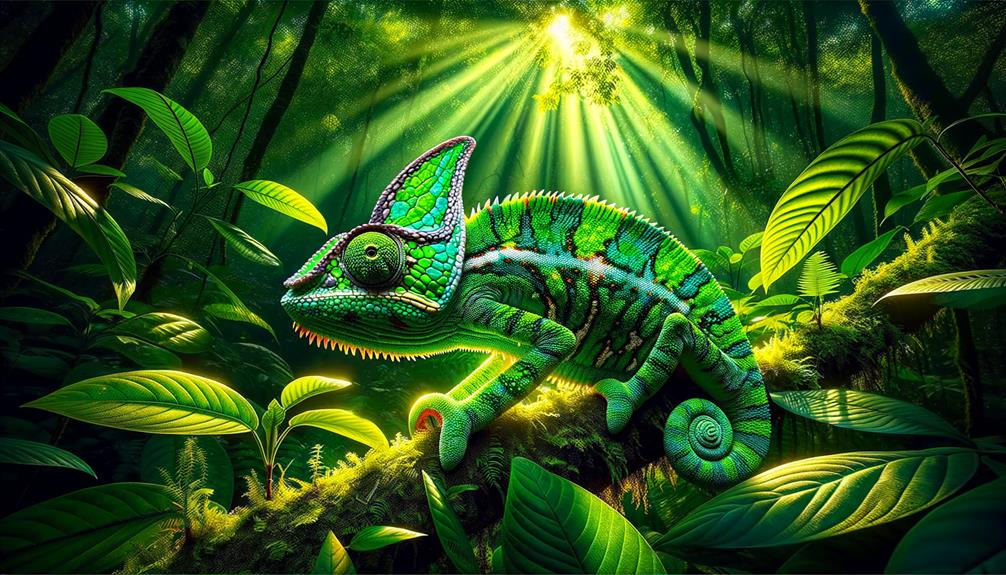
I find it fascinating how chameleons' ability to change color is not just about blending in, but also about regulating their body temperature and communicating with each other. Their habitat has a profound impact on these behaviors, influencing how they adapt to their surroundings. This adaptability is crucial for evading predators and catching prey, showcasing their remarkable evolutionary advantage.
Color Change Mechanisms
Harnessing their unique ability to change color, chameleons utilize specialized skin cells called chromatophores and iridophores to adapt to their environment, blending seamlessly into their surroundings and enhancing their camouflage and communication. Chromatophores contain pigments that rapidly expand or contract, altering the chameleon's coloration. Iridophores, on the other hand, house reflective guanine crystals, which can shift the wavelength of light reflected, adding another layer of color transformation.
The nervous system tightly controls these cells, enabling chameleon species to blend in with their environment for effective camouflage. This color change isn't just for hiding; it's also vital for regulating body temperature and signaling other chameleons.
Different chameleon species can shift between a broad palette of colors, ranging from greens and browns to striking blues and reds. This adaptability is crucial not only for avoiding predators but also for social interactions within their communities.
Here's how these mechanisms work:
| Cell Type | Function |
|---|---|
| Chromatophores | Expand/contract to change color |
| Iridophores | Reflect light, alter wavelengths |
| Nervous System | Controls cell activity |
Habitat Influences Behavior
Amidst the diverse ecosystems of rainforests, deserts, and savannas, chameleons exhibit a fascinating array of behaviors driven by their unique environmental adaptations. Their ability to change colors isn't just a clever trick; it's a sophisticated response to their surroundings, ensuring they thrive in various habitats. But what's truly captivating is how these color changes are more about communication and signaling rather than just blending in.
Research has revealed that chameleons' color-changing prowess is highly influenced by their habitat. Three key insights stand out:
Chameleons use their color changes to signal intentions to other chameleons, whether it's for mating or territorial disputes. This behavior is especially crucial in dense rainforests where visibility is limited.
While many might think color changes are purely for camouflage, studies suggest otherwise. Chameleons often match their surroundings to send signals rather than just hide, which is crucial in open savannas where predators can easily spot them.
Interestingly, the color spectrum of chameleons makes them more visible to avian predators. This indicates that their color changes serve as a balance between evading predators and ensuring effective communication with their peers.
In essence, chameleons' behavior and color-changing abilities are a testament to their remarkable environmental adaptation.
Predation Evasion Techniques
Chameleons have mastered the art of evading predators through a unique blend of physiological and behavioral adaptations. These remarkable creatures can change color rapidly using specialized skin cells called chromatophores, allowing them to blend seamlessly into their surroundings. This remarkable ability enables them to match the color, pattern, and texture of leaves, bark, and foliage, making them expert camouflagers.
In addition to their camouflage skills, chameleons can also regulate their body temperature by changing color. They darken to absorb heat and lighten to reflect it, allowing them to adapt to their environment. Their zygodactylous feet and prehensile tails also provide them with the agility to move stealthily and remain motionless on branches, further enhancing their camouflage. These physical traits enable them to navigate their habitat with precision, avoiding detection by predators.
Chameleons also possess exceptional eyesight, with eyes that can move independently, giving them a 360-degree arc of vision. This allows them to spot threats from any direction, making them highly effective at avoiding predators. Their remarkable camouflage abilities, combined with their exceptional eyesight, make chameleons highly adept at surviving in diverse environments.
Predator Evasion Techniques
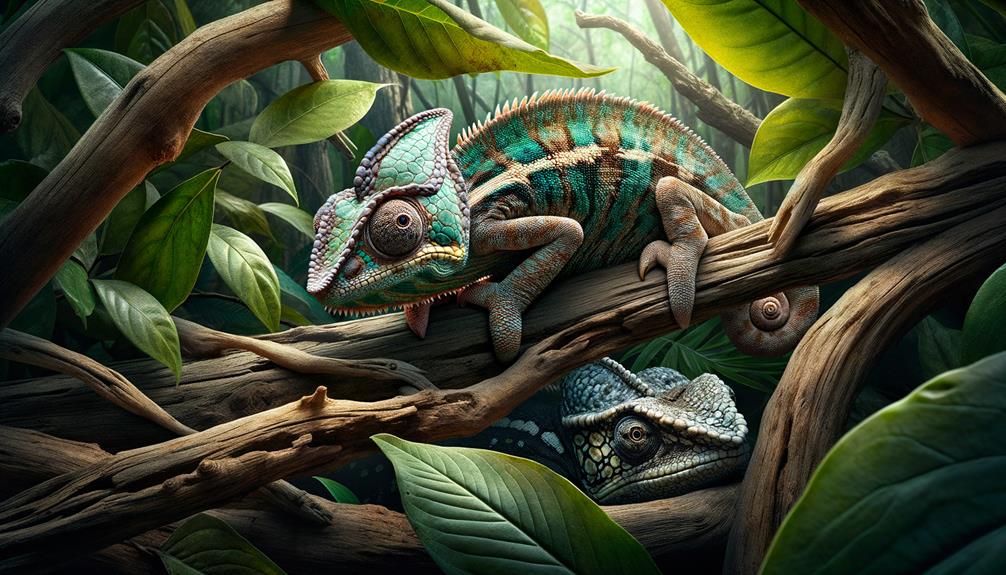
Chameleons have mastered the art of predator evasion, and their remarkable ability to change color is just one of the tools in their arsenal. This incredible skill allows them to blend seamlessly into their surroundings, communicate with others, and even signal to potential threats. It's more than just a clever trick – it's a vital survival strategy.
Larger chameleon species, which face more significant threats, have evolved more complex color palettes to stay one step ahead of predators. Their independently moving eyes are like built-in surveillance cameras, scanning their environment without giving away their position. This 360-degree field of vision is crucial for early threat detection. When combined with their unique feet and prehensile tails, chameleons can remain perfectly still, blending into their environment and avoiding detection.
Chameleons employ three key techniques to evade predators:
- Color Change: They blend into their surroundings to avoid being seen.
- Motionless Stance: Using their unique feet and tails to stay perfectly still.
- Exceptional Eyesight: Independently moving eyes to monitor their environment without revealing their position.
These clever techniques, honed through evolution, give chameleons a significant advantage in the wild, ensuring their survival and freedom from predators.
Hunting and Feeding

Chameleons are stealthy hunters, equipped with exceptional camouflage and keen eyesight. These remarkable reptiles have evolved unique adaptations that make them masters of their domain.
With their independent eye movement, chameleons can focus on two different objects simultaneously, allowing them to track potential prey with unparalleled ability. From their vantage points on branches and foliage, their zygodactylous feet and prehensile tails enable them to silently stalk and ambush targets. When a chameleon locks onto its prey, it deploys its long, sticky tongue, which can extend over half the length of its body, to snatch the target with astonishing speed and precision.
Their color-changing abilities further enhance their hunting prowess. By blending seamlessly into their surroundings, chameleons remain undetected, both by prey and potential predators. This camouflage not only aids in hunting but also secures their survival in the wild.
In essence, chameleons exemplify the art of stealth and precision in hunting. Their unique adaptations make them true masters of camouflage and efficient predators in their natural environments.
Natural Habitat

Chameleons inhabit a range of environments, from the lush rainforests of Madagascar to the arid deserts of Africa, each species uniquely adapted to its specific ecological niche. These fascinating reptiles belong to the family Chamaeleonidae and have spread across various continents, including southern Europe and parts of Asia.
The diversity of chameleon habitats is astounding. You'll find them in:
Rainforests, where they thrive in the dense foliage, using their camouflage to blend into the vibrant greens and browns of the forest.
Deserts and Savannas, where they have adapted to survive with minimal water, blending into the sandy and rocky landscapes.
Mountains, where high-altitude chameleons have developed unique adaptations to cope with cooler temperatures and less oxygen.
Each species' ability to camouflage is crucial for their survival. While their distribution may be widespread, many chameleons are confined to small, specialized ranges, making them vulnerable to habitat loss and environmental changes. This specialization allows them to master their specific habitats, but it also highlights their fragility in the face of rapid ecological shifts. Understanding these habitats is vital for their conservation and our appreciation of their natural artistry.
Frequently Asked Questions
What Are 5 Interesting Facts About Chameleons?
Chameleons are fascinating creatures that can change color rapidly, giving them an incredible ability to blend in with their surroundings. They also boast 360-degree vision, thanks to their unique eye structure that allows them to move their eyes independently. Their prehensile tails are perfect for climbing and grasping, and their specialized feet are designed for gripping. These remarkable animals can be found in diverse habitats across Africa, Madagascar, Europe, and Asia.
Do Chameleons Actually Camouflage?
Chameleons do indeed camouflage, but recent research suggests that their color-changing abilities serve primarily as a means of communication and signaling. This finding challenges the long-held notion that blending into their environment is their primary purpose.
How Do Chameleons Know What Color to Change To?
Chameleons are masters of disguise, and their ability to change color is a remarkable feat of biology. With their sharp eyesight, they can detect the dominant colors of their surroundings and adjust their skin color to blend in seamlessly. It's an intricate process that involves precise control over specialized cells called chromatophores, allowing them to change their appearance in a split second. This remarkable ability is a testament to the chameleon's remarkable adaptability and its ability to thrive in its environment.
Can a Chameleon Easily Camouflage?
Chameleons have an incredible ability to camouflage. They achieve this through specialized skin cells called chromatophores, which allow them to rapidly change color. This remarkable skill enables them to blend seamlessly into their environment, convey emotions, and even regulate their body temperature. It's truly fascinating!


